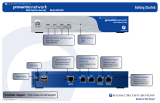
IBM Internet Security Systems, Inc.
6303 Barfield Road
Atlanta, Georgia 30328-4233
United States
(404) 236-2600
http://www.iss.net
Copyright © 2003, 2007 IBM Corporation. All rights reserved worldwide.
Customers may make reasonable numbers of copies of this publication for internal use only. This publication may not otherwise
be copied or reproduced, in whole or in part, by any other person or entity without the express prior written consent of Internet
Security Systems, Inc.
Patent Pending.
Internet Security Systems, ADDME, ActiveAlert, AlertCon, Dynamic Threat Protection, FireCell, FlexCheck, SecurityFusion,
SecurePartner, SiteProtector, SecureU, System Scanner, Virtual Patch, Wireless Scanner, and X-Press Update are trademarks and
service marks; Database Scanner, Internet Scanner, the Internet Security Systems logo, Online Scanner, Proventia, RealSecure,
SAFEsuite, Secure Steps, and X-Force are registered trademarks and service marks of Internet Security Systems, Inc. Network
ICE, the Network ICE logo, and ICEpac are trademarks, BlackICE a licensed trademark, and ICEcap a registered trademark of
Network ICE Corporation, a wholly owned subsidiary of Internet Security Systems, Inc. Powering Content Security is a
trademark and Cobion is a registered trademark of Cobion AG, a wholly owned subsidiary of Internet Security Systems, Inc.
SilentRunner is a registered trademark of Raytheon Company. Acrobat and Adobe are registered trademarks of Adobe Systems
Incorporated. Certicom is a trademark and Security Builder is a registered trademark of Certicom Corp. Check Point,
FireWall-1, OPSEC, Provider-1, and VPN-1 are registered trademarks of Check Point Software Technologies Ltd. or its affiliates.
Cisco and Cisco IOS are registered trademarks of Cisco Systems, Inc. HP-UX and OpenView are registered trademarks of
Hewlett-Packard Company. IBM and AIX are registered trademarks of IBM Corporation. InstallShield is a registered trademark
and service mark of InstallShield Software Corporation in the United States and/or other countries. Intel and Pentium are
registered trademarks of Intel. Lucent is a trademark of Lucent Technologies, Inc. ActiveX, Microsoft, Windows, and Windows
NT are either registered trademarks or trademarks of Microsoft Corporation. Net8, Oracle, Oracle8, SQL*Loader, and SQL*Plus
are trademarks or registered trademarks of Oracle Corporation. Seagate Crystal Reports, Seagate Info, Seagate, Seagate
Software, and the Seagate logo are trademarks or registered trademarks of Seagate Software Holdings, Inc. and/or Seagate
Technology, Inc. Secure Shell and SSH are trademarks or registered trademarks of SSH Communications Security. iplanet, Sun,
Sun Microsystems, the Sun Logo, Netra, SHIELD, Solaris, SPARC, and UltraSPARC are trademarks or registered trademarks of
Sun Microsystems, Inc. in the United States and other countries. All SPARC trademarks are used under license and are
trademarks or registered trademarks of SPARC International, Inc. in the United States and other countries. Adaptive Server,
SQL, SQL Server, and Sybase are trademarks of Sybase, Inc., its affiliates and licensers. Tivoli is a registered trademark of Tivoli
Systems Inc. UNIX is a registered trademark in the United States and other countries, licensed exclusively through X/Open
Company, Ltd. All other trademarks are the property of their respective owners and are used here in an editorial context
without intent of infringement. Specifications are subject to change without notice.
Disclaimer: The information contained in this document may change without notice, and may have been altered or changed if
you have received it from a source other than ISS or the X-Force. Use of this information constitutes acceptance for use in an
“AS IS” condition, without warranties of any kind, and any use of this information is at the user’s own risk. ISS and the X-Force
disclaim all warranties, either expressed or implied, including the warranties of merchantability and fitness for a particular
purpose. In no event shall ISS or the X-Force be liable for any damages whatsoever, including direct, indirect, incidental,
consequential or special damages, arising from the use or dissemination hereof, even if ISS or the X-Force has been advised of
the possibility of such damages. Some states do not allow the exclusion or limitation of liability for consequential or incidental
damages, so the foregoing limitation may not apply.
Reference herein to any specific commercial products, process, or service by trade name, trademark, manufacturer, or
otherwise, does not necessarily constitute or imply its endorsement, recommendation, or favoring by Internet Security Systems,
Inc. The views and opinions of authors expressed herein do not necessarily state or reflect those of Internet Security Systems,
Inc., and shall not be used for advertising or product endorsement purposes.
Links and addresses to Internet resources are inspected thoroughly prior to release, but the ever-changing nature of the Internet
prevents Internet Security Systems from guaranteeing the content or existence of the resource. When possible, the reference
contains alternate sites or keywords that could be used to acquire the information by other methods. If you find a broken or
inappropriate link, please send an email with the topic name, link, and its behavior to
support@iss.net
.
August 8, 2007





















